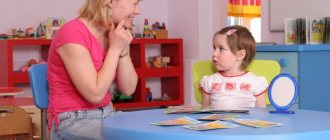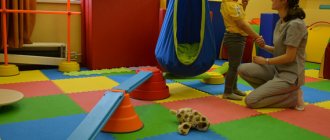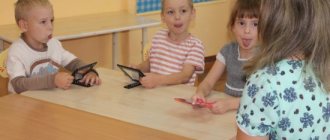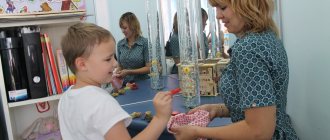How to make a presentation to a speech therapist for a parent meeting
At the beginning of the school year, the school speech therapist meets the parents of first-graders. He talks about himself and what he does with children. How he selects schoolchildren for classes, gives a lot of different information on other important issues. It is very good to support your speech with a pre-compiled presentation. The classroom equipment allows for presentations, and the benefits of this are undoubted.
Why do you need a presentation to a speech therapist?
As practice shows, parents do not remember the usual speech of a speech therapist. At the meeting, many strangers speak with a variety of questions. It can be difficult to maintain attention the entire time. A presentation helps you stand out and convey important information not only through speech, but also through video.
As a result:
- your information has been heard and you will not say the same thing to each of the parents;
- all necessary points are recorded;
- no need to raise your voice and repeat - just leave the slide a little longer to view,
- if necessary, you can easily return to the previous slide and not lose the thread of the story,
- nothing will be missed - you will definitely say everything you planned.
Preparing a presentation for a speech therapist does not take much more time than preparing a regular speech. A well-thought-out presentation can be used for several years, supplemented with relevant information from time to time.
How to make a presentation?
A speech therapist needs to know the general principles of making presentations. They are simple and easy to remember and then implement.
1. There should be few slides. Optimally 5-10 pieces. 2. Each slide must contain separate information. 3. Pictures should occupy most of the slide. 4. Use text to a minimum, only the most important. For example, what needs to be written down or what should be emphasized. 5. The human brain remembers images better, so use them.
Filling the slides
The content of the slides may be different, but there is something that must be indicated. The speech therapist’s presentation will roughly look like this.
Slide one: introduction
Introduce yourself. Write your last name, first name and patronymic, position, number of the office in which you work. If this is part of your plans, here you can also place a phone number where you can be contacted and the hours when this can be done. It is better to speak about your education, practice, and work experience in words. Give parents time to transfer the data from the slide to their notebooks. Please note: modern parents often do not write down information from slides, but take photographs of it. Therefore, highlight important points in bold and do not use a pockmarked background, which makes it difficult to perceive the text, or even disguises it.
Slide two: problem statement
Tell us why a speech therapist is needed at school. Here, provide information about problems specific to first-graders at your school. Perhaps unformed speech, lack of active attention, functional immaturity and others. It would be good if you could provide statistical data, including for your school. Only the names of the problems should appear on the slide (and if possible, thematic pictures); tell them in more detail orally.
Slide three: updating the problem
After listening to a number of problems, even with statistics, parents are unlikely to understand how serious they are. And most likely, they will not connect them with their child. Therefore, the problem needs to be updated. Tell us in an accessible way what speech therapy problems threaten first-graders. That there will be difficulties with reading comprehension, writing and literacy. A good sign is the parents' revival. Support him. You may be asked questions. Keep your answers short but clear.
Slide four: problem solving
Information can be located on 2-5 slides. You need to tell in detail what you do, how you help children settle into school, become more attentive, literate and smart. Adhere to the principle: on one slide - one problem, illustrated with a picture. Emphasize that the work will be carried out comprehensively and that parents are also involved in this. Start with how and when selection for classes will take place. Proceed to speech therapy support, individual and group work. Tell your story based on the picture on the slide.
Slide five: general recommendations
This is the final slide. It provides recommendations for daily work with children at home.
Typically there are three recommendations:
1. read aloud to the child, 2. communicate more often, 3. answer all the child’s questions, do not brush them aside, treat them with understanding.
Emphasize once again that if any questions arise, parents should not hesitate to contact you. Re-show your phone number, first and middle name, and time to call at the end of the slide.
Speech therapist Master consults and trains school speech therapists on-site and remotely. You can choose a suitable course or master class, including on all school aspects of the work of a speech therapist. All information is available on the website. You can sign up by phone or by filling out an application on the website. Improve your skills and your work will always delight you!
Presentation on the topic: advice from a speech therapist
Slide description: Advice from a speech therapist Consultations for parents Adaptation generally lasts from two to six months, depending on the individual characteristics of the first-grader. Some children lose weight by the end of the first quarter, many experience a decrease in blood pressure (which is a sign of fatigue), and some experience a significant increase (a sign of real fatigue). In many first-graders, parents observe headaches, fatigue, poor sleep, decreased appetite; doctors note the appearance of heart murmurs, neuropsychic health disorders and other ailments. The majority (56%) adapt within the first two months of training. These children relatively quickly join the team, get comfortable in the classroom, and make new friends; They are almost always in a good mood, they are calm, friendly, and fulfill the teacher’s demands conscientiously and without visible tension. The second group of children (30%) needs more time; for a month, and another, and a third, they can play in class or sort things out with a friend, without reacting to the teacher’s comments (or reacting with tears and hysterics). And things are not easy for them when it comes to mastering the curriculum. Only by the end of the first half of the year does their behavior become “correct.” The third group (14%) are children who, in addition to significant difficulties in academic matters, have difficulties of a more serious nature. They exhibit negative forms of behavior and sudden outbursts of negative emotions. If you do not understand the reasons for this behavior in time, it can lead to a nervous breakdown and mental health problems. It is during the first quarter that the number of students with neuropsychiatric disabilities increases by approximately 14-16%, and by the end of the school year the number of such children increases by approximately 20%. How to help..? The most basic thing is adherence to the regime. Following a daily routine allows the child to maintain physical and mental balance, which makes it possible to maintain emotional balance. After school, a first grader must first have lunch and rest. Relax in the air, in active games, in movement. For weakened children, the best rest would be an hour and a half nap in a well-ventilated room. Sleep also helps relieve stress on the musculoskeletal system. It is better to do lessons in the middle of the day. It is believed that brain activity has two peaks during the day: 9-12 hours and 16-18 hours, when it makes sense to do homework.
Speech therapist for schoolchildren
Parent meeting “What is dysgraphia and how to help a dysgraphic child?”
Prepared by: teacher-speech therapist of MAOU “Gymnasium No. 6” in the city of Gubkin, Belgorod region, Natalya Viktorovna Mashkina.
2 slide
As they begin school, some children suddenly develop difficulties with reading and writing. The guys find themselves at odds with the Russian language, although they do well in mathematics and other subjects where, it would seem, more intelligence is required. Sooner or later, such “smart” ones, but lacking speech talent, are sometimes referred to a speech therapist. More often to a psychologist, which is not entirely correct. Dysgraphia is a partial specific writing disorder.
There are five forms of dysgraphia:
Material from the site
1. Articulatory-acoustic form of dysgraphia.
Its essence is as follows: A child who has a violation of sound pronunciation, relying on his incorrect pronunciation, records it in writing.
In other words, he writes as he pronounces. This means that until the sound pronunciation is corrected, it is impossible to correct writing based on pronunciation. 2. Acoustic form of dysgraphia.
This form of dysgraphia manifests itself in the substitution of letters corresponding to phonetically similar sounds.
At the same time, in oral speech, sounds are pronounced correctly. In writing, letters are most often mixed, indicating voiced - unvoiced (B-P; V-F; D-T; Zh-Sh, etc.), whistling - hissing (S-Sh; Z-Zh, etc.). ), affricates and components included in their composition (CH-SH; CH-TH; C-T; C-S, etc.). It also manifests itself in the incorrect designation of the softness of consonants in writing: “pismo”, “lubit”, “hurt”, etc. 3. Dysgraphia due to a violation of language analysis and synthesis.
This is the most common form of dysgraphia in children suffering from written language disorders. The following errors are most typical for it:
? omissions of letters and syllables;
rearrangement of letters and (or) syllables;
underwriting of words;
writing extra letters in a word (this happens when a child, while pronouncing while writing, “sings the sound” for a very long time;
repetition of letters and (or) syllables;
contamination - syllables of different words in one word;
? continuous writing of prepositions, separate writing of prefixes (“on the table”, “on stepped”). 4. Agrammatic dysgraphia.
Associated with underdevelopment of the grammatical structure of speech.
The child writes ungrammatically, i.e. as if contrary to the rules of grammar (“beautiful bag”, “happy day”). Agrammatisms in writing are noted at the level of words, phrases, sentences and text. Agrammatic dysgraphia usually manifests itself from the 3rd grade, when a student who has already mastered literacy “closely” begins to study grammatical rules. And here it suddenly turns out that he cannot master the rules of changing words according to cases, numbers, and gender. This is expressed in incorrect spelling of the endings of words, in the inability to coordinate words with each other. 5. Optical dysgraphia.
Optical dysgraphia is based on insufficient development of visual-spatial concepts and visual analysis and synthesis. All letters of the Russian alphabet consist of a set of the same elements (“sticks”, “ovals”) and several “specific” elements. Identical elements are combined in different ways in space and form different letter signs: i, w, c, sch; b, c, d, y... If a child does not catch the subtle differences between letters, then this will certainly lead to difficulties in mastering the outline of letters and to incorrect representation of them in writing. Errors that are most common in writing: - underwriting of letter elements (due to underestimation of their number): L instead of M; X instead of F, etc.; — adding extra elements; - omissions of elements, especially when connecting letters that include the same element; - mirror writing of letters.
3 slide
What you need to pay special attention to:
1. If your child is left-handed. 2. If he is a retrained right-hander. 3. If your child attended a speech therapy group. 4. If the family speaks two or more languages. 5. If your child went to school too early (learning to read and write unjustifiably earlier sometimes provokes the occurrence of dysgraphia and dyslexia.) This happens in cases where the child has not yet reached the psychological readiness for such learning. 6. If your child has problems with memory and attention. 7. Mixing letters by optical similarity: b-p, t-p, a-o, e-z, d-u. 8. Errors caused by impaired pronunciation, the child writes what he says: leka (river), suba (fur coat). 9. With impaired phonemic perception, the vowels o-u, e-yu, consonants r-l, y-l, paired voiced and voiceless consonants, whistling and hissing, sounds ts, ch, shch are mixed. For example: tynya (melon), klyokva (cranberry). 10. Missing letters, syllables, missing words. For example: prta - desk, moko - milk, cheerful (cheerful).
Dear readers, please note! Dysgraphia never comes out of nowhere! Work to eliminate dysgraphia should begin not at school, when specific errors in writing are discovered, but in preschool age, long before the child begins to learn to read and write. Children suffering from dysgraphia need special speech therapy help, since specific writing errors cannot be overcome by conventional school methods. It is important to consider that dysgraphia is much easier to prevent than to eliminate.
4 slide
Who can teach a child to read and write?
Mom and dad are unlikely to succeed; they need the help of a specialist - a qualified speech therapist. Classes are conducted according to a specific system: various speech games, a split or magnetic alphabet for adding words, and highlighting the grammatical elements of words are used. The child must learn how certain sounds are pronounced and which letter this sound corresponds to when writing. Typically, a speech therapist resorts to contrasts, “working out” how hard pronunciation differs from soft pronunciation, and dull pronunciation from voiced pronunciation. Training is carried out by repeating words, dictation, selecting words based on given sounds, and analyzing the sound-letter composition of words. It is clear that they use visual material to help remember the shapes of letters: “O” resembles a hoop, “F” - a beetle, “C” - a crescent... Strive to increase the speed of reading and writing.
5 slide
Some tips for parents:
1. If a child is assigned to read a text at home or write a lot, then break the text into parts and complete the task in several steps. 2. Do not force your child to rewrite homework many times; this will not only harm the child’s health, but also instill in him insecurity, and also increase the number of mistakes. 3. Praise your child for every success achieved, humiliate him as little as possible.
6 slide
A few words about handwriting.
The handwriting of a dysgraphic person is an expression of all his difficulties. As a rule, in a dysgraphic person two types of handwriting stand out quite sharply: one is small, beady and “beautiful”; the other is huge, clumsy, clumsy, “ugly.” So, in this case there is no need to chase beauty, it will come on its own. As experience shows, clumsy and huge letters are precisely what a child should ultimately come to and work on. This handwriting is his real face, the face of an honest first-grader who wants and can learn (our first-grader, by the way, can be 10 or 16 years old, we are talking about the psychological age of learning to write).
So, DOWN with the beaded chain of letters, LONG LIVE the sweeping handwriting, for the entire line, or maybe one and a half!
7 slide
HOW TO TEACH.
Everything is quite simple here. For some time (usually two to three weeks is enough for this), a paragraph of text from any work of art or an exercise from a SMALL SIZE textbook is copied EVERY DAY in a notebook. The text, which is VERY IMPORTANT, is rewritten in CELLS, ONE LETTER PER CELL, THE LETTER MUST OCCUPY THE WHOLE CELL!
Material from the site
The psychological preparation of the child for classes is also important here. In an unfavorable psychological atmosphere, classes “under pressure”, there may be no results. The volume of text, I emphasize once again, should be small; for a child under ten years old it can be only one line a day, but it should be clearly rewritten. The overall goal is to prevent the slightest disgust, fatigue, or even dissatisfaction with yourself!
8 slide
There are tricks to choosing stationery for dysgraphics.
Massaging your fingertips is important for proper brain function when writing. This is what I recommend to ALL speech therapists. Therefore, it is good if the place of “grip” of a writing object (pen or pencil) is covered with ribs or pimples.
But it’s even better if the student is comfortable holding this very pen, then the handwriting is more likely to stabilize. And for this, the body must be triangular. Such pens and pencils for dysgraphics with a triple section to support three holding fingers are produced, for example, by the company /deleted by the administrator/. There are triangular pencils and felt-tip pens from the company /removed by the administrator/. Unfortunately, I have not yet seen both “conveniences” combined: the triangle and the pimples. So buy a bubble pen and a triangular pencil.
I would also like to note that stationery that has some special features will be a source of little pride for the child in front of his classmates, which can at least slightly smooth out school failures.
Girls often like to buy pens with multi-colored, shiny, etc. paste, fortunately they are allowed to write with them (in music lessons, labor lessons, etc.). So let it be better that the value of a pen in a child’s eyes be a beautiful, colored, unusually shaped body than a colored gel that makes it dazzle in the eyes and in the notebook. When buying a pen, check how it writes and whether the ink bleeds through to the other side of the page.
Gel pens are considered the most suitable for dysgraphics (pressure is felt), but in first grade they will most likely be prohibited from using them: they often leak, freeze, and spoil. Therefore, at home, it is useful for even the youngest to play a medieval scribe - to practice writing with a feather and ink (if parents do not know how, then you can ask your grandparents). “Pen” writing forms the correct position of the hand relative to the surface of the paper. At the same time, however, there is a fascinating opportunity to get smeared with ink and smear your notebook, table, nose, knees, etc., so be careful.
Slide 9
A FEW EXERCISES to help overcome dysgraphia
I would like to warn you that these exercises will not eliminate the problem, but will help parents in overcoming dysgraphia and will help the speech therapist work on the defect.
Exercise "Proofreading".
For this exercise you need a book, boring and with a fairly large (not small) font. The student works every day for five (no more) minutes on the following task: crosses out the given letters in a continuous text. You need to start with one letter, for example, “a”. Then “o”, then the consonants with which there are problems, first they also need to be asked one at a time. After 5-6 days of such classes, we switch to two letters, one is crossed out, the other is underlined or circled. The letters should be “paired”, “similar” in the student’s mind. For example, as practice shows, most often difficulties arise with the pairs “p/t”, “p/r”, “m/l” (spelling similarity); “y/d”, “y/y”, “d/b” (in the latter case the child forgets whether the tail of the circle is pointing up or down), etc.
The pairs required for development can be established when viewing any text written by your child. After seeing the correction, ask what letter he wanted to write here. More often than not, everything is clear without explanation.
Attention! It’s better if the text is not read (that’s why the book needs to be boring). All attention must be concentrated on finding the given shape of a letter, one or two, and work only with them.
10 slide
Exercise “Writing out loud.”
An extremely important and irreplaceable technique: everything that is written is spoken out loud by the writer at the time of writing and the way it is written, with underlining and highlighting weak parts.
That is, “Another O-din h-rez-you-cha-Y-but-important reception” (after all, in fact, we say something like “LOOKING FOR AN EMERGENCY IMPORTANT PREMIERE”). The example is simpler: “ON THE TABLE WAS A JUG WITH MILK” (a jug of malak melted on the steel). By “weak beats” we mean sounds that, when pronounced in fluent speech, the speaker pays the least attention to. For vowel sounds, this is any unstressed position; for consonants, for example, a position at the end of a word, such as “zu*p”, or before a voiceless consonant, such as “lo*shka”. It is also important to clearly pronounce the end of the word, since for a dysgraphic person it is difficult to finish the word to the end, and often for this reason the habit of “putting sticks” is developed, i.e. add an indefinite number of squiggle sticks to the end of a word, which at a quick glance can be mistaken for letters. But the number of these squiggles and their quality do not correspond to the letters at the end of the word. It is important to determine whether your child has developed this habit. However, regardless of whether it exists or not, we get used to consistency and gradual pronunciation, we pronounce every word we write down!
11 slide
“Take a closer look and figure it out” (punctuation for dysgraphics and more).
Material for work - collections of dictations (with commas already added, and check that there are no typos).
Assignment: carefully reading, “photographing” the text, explain the placement of each punctuation mark out loud. It is better (for middle and older age) if the explanation sounds like this: “The comma between the adjective “clear” and the conjunction “and”, firstly, closes the participial phrase “...”, and secondly, separates the two parts of the complex sentence ( grammatical basics: the first “…”, the second “…”), connected by the conjunction “and”.
12 slide
"Missing letters"
When performing this exercise, it is suggested to use the hint text, where all the missing letters are in their places. The exercise develops attention and confidence in writing skills. For example:
Of course, no matter what, what Lariosik __to the hall is going to eat. In no way __l__ch__e m__f__t b__t__ n__ st__ro__e Petliura in__el__ig__n__n__y ch__l__we__ in__ob__e, but d__en__lm__n, p__d__i__av__iy cheerful on s__m__es__t p__t you__ya__ and p__sy__a__shchi__ __el__g__a__we in __es__es __t tr__ s__ov__, in ch__st__o__ty... M__shi__nym small__lo__ and k__ro__i__om on__lu__sh__m about__az__m b__li s__aza__y and nay-tours Colt and Al__shin brau__ing . Lariosik, p__d__b__o Nikolka, z__su__il __uk__v__ and p__m__ga__ __maz__va__y and __kl__dy__at__ all__ in d__in__u__ and __y__o__uyu tough__uyu k__rob__u __z-__od ka__am__l__. __ab__ta __y__a sp__shn__y, ib__ to each __ply__och__u chlo__e__u, u__a__your__avsh__mu in rev__i__, o__li__but and__v__st__o, __t__ o__y__ki pr__ __s__h vl__st__h __ro__sho__yat from __wu__ cha__ov t__i__t__ti __in__t __ o__and until __an hour__on Monday__and m__nu__ ut__a z__mo__ and from __day__and th__so__ but__i to __four__h __tra le__o__. V__e ra__ot__ z_-d__rzh__la__y, bl__go__a_-ya Lariosik, who__to__y__, zako__ya__y with __with__ro__st__om activity p__sto__eta with__s__em__ Colt, involved in __y__ku __battle__u not t__m __end__m and, __t__b __ in__ta__it__ e__, __on__do__il__sn__chi__ate__but__ us__le__e and __or__do__but__ to__li__e__t__o m__sl__. Kr__m__ that__o, pr__izol__o in__or__e and n__zhi__a__no__ pr__pya__st__i__: k__ro__k__ with v__o__en__m__ in n__e re__ol__we__am__, p__go__a__i Nikolki and Al__ks__ya, she__ro__om and __ar__o__ko__ __a__le__n__ka A__ek__e__, k__r__b__a, in __lo__e__na__ in__u__r__ __lo__m par__fi__ov__y __um__gi and s__a__zh__ p__ in__e__ __v__m __bl__p__e__na__ li__kim__ __olo__am__ __le__t__i__e__ko__ __z__lya__i, n__ __ro__es__a in f__rto__k__.
Slide 13
Labyrinths.
Labyrinths are good for developing gross motor skills (movements of the hand and forearm), attention, and continuous line. Make sure your child changes the position of his hand, not the sheet of paper.
Slide 14
Dictations must be written! Only in a special way.
1. Extremely slow!
Material from the site
At the initial stage of eliminating dysgraphia, a dysgraphic applicant should spend at least an hour writing a dictation of 150 words. Why so long? This can be seen from the following points.
2. The text is read in its entirety. You can ask what spelling/punctuation this text is based on. Your student is unlikely to answer, since he has already decided that this is “not for him,” so remember and lightly point out them yourself, find out whether the concepts of “unstressed vowels” and “participial/adverbial phrase” are known.
Then the first sentence is dictated. Ask the student to name the number of commas in it and try to explain them. Do not insist, suggest, encourage the attempt to give the correct answer. Ask them to spell one or two difficult (or simply long) words. Only then (after reading it twice, or even three or four times).
3. The sentence is dictated in parts and written down, pronouncing out loud all the features of pronunciation and punctuation marks.
15 slide
What not to do?
Children with dysgraphia usually have good visual memory. Therefore, under no circumstances should you offer them exercises where you need to correct mistakes that were initially made. Performing such exercises can have a detrimental effect (due to the same visual memory) on students who have the skill of writing correctly. DO NOT ASK YOUR CHILDREN TO CORRECT MISTAKES, TEACH THEM NOT TO MAKE MISTAKES. The essence of correcting dysgraphia is to eradicate the very idea that these same mistakes can be made when writing. A text with errors once again shows the child that mistakes are possible, and perhaps even useful in some ways. Let's forget about this...
16 slide
Thank you for your attention!
Slide 17
Bibliography:
1. Ananyev B. G. Analysis of difficulties in the process of mastering reading and writing. Izvestia of the APN R.-SFSR 1950.-Issue 70 2. Levina R. E. Writing impairment in children with speech underdevelopment. - M., 1961 3. Sadovnikova I. N. Impairment of written speech in primary schoolchildren. - M., 1983
We wish you success!
Speech therapist in kindergarten presentation on speech therapy
Slide 1
Speech therapist in kindergarten Volsk d/s No. 24 “Rodnichok”
Slide 2
What do speech therapists do? What do speech therapists do? The global goal of speech therapy intervention is the DEVELOPMENT of the WHOLE SPEECH SYSTEM as a whole, and not just the production of sounds. Development of general speech activity Accumulation of vocabulary Development of physical and speech hearing Development of the grammatical side of speech Training in word formation and inflection skills Development of articulatory motor skills Development of coherent speech Correction of sound pronunciation
Slide 3
What do speech therapists do? Reasons for difficulties in speech development in children: Some children cannot learn to speak correctly without the help of a specialist. There are many reasons. Here are some of them: Organic damage to areas of the brain responsible for speech. (during difficult childbirth, in the prenatal state or early periods of life) Congenital insufficient supply of nerve endings to the speech organs. Spasms of the muscles of the speech apparatus. Malocclusion. Difficult psychological climate in the family
Slide 4
What do speech therapists do? What to look for in your child: If at 3-3.5 years old: The child pronounces only individual words and does not construct phrases and sentences at all. His speech completely lacks conjunctions and pronouns. He doesn't repeat your words. Or you don’t understand his speech at all (distortion of hissing and voiced consonants (r, l) sounds is the norm).
Slide 5
What do speech therapists do? What to look for in your child: If at 4 years old: The child has a very poor vocabulary (normally about 2000 words). Can't remember quatrains. Doesn’t tell his own stories at all (however, mistakes when composing sentences, the absence of “complex” sounds are the norm).
Slide 6
What do speech therapists do? What to look for in your child: If at 5-6 years old: There are still problems with sound pronunciation. The child is not able to describe the plot in the picture in his own words. Makes gross mistakes when constructing sentences (mistakes are made in complex sentences, slight inconsistency in the narration)
Slide 7
Norms for mastering sounds
Slide 8
What is a speech therapy correction group? A speech therapy correctional group is a separate group of a kindergarten that accepts children 5-6 years old (sometimes earlier) with speech disorders. Classes with children are intensive; compared to a regular kindergarten group, there are almost twice as many of them. Speech is closely related to the memory and mental development of a child. Practice shows that modern speech therapy groups prepare children for school better than regular ones. A speech therapy group in a kindergarten is neither good nor evil, it is a necessity for those children who need speech correction. Therefore, if they plan to transfer your child to a speech therapy group, do not be upset - this is for his benefit. If there is no evidence, don’t go there.
Slide 9
Dear parents! Be your children's best helper. If your child is visiting a speech therapist, know that poor speech cannot be corrected in one or even two sessions. This will require time and joint efforts of the speech therapist, the child and his parents. Sound correction is carried out in stages: Stage 1 – preparatory (special exercises for lips, tongue, voice, breathing, etc.); Stage 2 – production (producing sounds by imitation or using special techniques); Stage 3 – automation (fixing sound in syllables, words, sentences); Stage 4 – differentiation (in cases of replacing one sound with another). The preparatory stage and the stage of consolidation of a new sound for many children proceeds slowly and requires long training. To achieve free, clear pronunciation of sounds in speech, you need to practice a lot.
Advice from a speech therapist to parents of future first-graders
Slide 0
Advice from a teacher-speech therapist to parents of future first-graders Teacher-speech therapist GBOU School No. 629 Kunakh Svetlana Mikhailovna
Slide 1
Dear mothers and fathers, grandparents! Correct speech is the most important condition for a child’s successful education at school. The better a child’s oral speech is developed, the easier it will be for him to master reading and writing. Many children often experience a mild delay in speech development, which in preschool age usually does not attract much attention, but in the future it can interfere with good studies and lead to specific errors, for example, in Russian language lessons. Therefore, it is very important to identify even the most minor deviations in the child’s speech development and correct them before he begins to learn to read and write.
Slide 2
Parents should pay attention to the following: 1. The state of sound pronunciation. By the age of six, a child should clearly pronounce all sounds. 2. State of phonemic processes. This is the child’s ability to select words with a certain sound, mastery of the skills of elementary sound analysis and synthesis (determination of the first and last sounds in a word, the ability to compose a word from sounds, count the number of sounds), the ability to distinguish and repeat combinations like: ba-pa-ba, ta -tsa-ta, you-you-fy, etc. 3. State of grammatical structure. You should pay attention to word formation (rain - rain), inflection (chair - chairs), agreement (yellow ball), control (left the house, talked about a friend). 4. The state of the syllabic structure of the word. A six-year-old child can accurately pronounce words like: cyclist, tour guide, etc. 5. State of vocabulary The vocabulary of a 6-year-old child should contain about 2000 words. All parts of speech are represented. 6. State of coherent speech Teach children to answer questions in complete sentences, offer to compose a fairy tale, continue a sentence, describe what is happening on the street, a picture, retell a fairy tale, story, etc.
Slide 3
What you should pay attention to: The state of spatial functions (the ability to determine “right - left” in various conditions, body positions, the ability to recognize objects, letters in different positions; Communication functions (communication with children, adults, the ability to listen, remember and follow instructions); The state of gaming activity (the ability to play independently, in groups, the development of a story game, the ability to invent and accept rules); Motivation (the presence of a desire to learn, learn new things); Development of elementary mathematical skills (counting within 10, solving elementary problems); Development of attention processes , memory (for example, memorizing 7-8 words, objects); Development of thinking (generalization “name it in one word”, classification “divide into groups”, highlighting the unnecessary with an explanation); Sense of rhythm (the child taps, claps the given rhythm). If the child reads, then the reading should be smooth, syllable by syllable, the child understands what he read. Writing before school is only in block letters, there are no mirrored letters.
Slide 4
Recommendations for developing correct speech skills: Pay the child’s attention to the process of cooking, e.g. qualities, composition, products from which the dish is prepared (for example, how we cook: cook, fry, bake, clean; taste qualities: tasty, sweet, bitter, hot, cold; color: green, yellow). The role of favorite toys in a child’s development, including the formation of coherent speech, is invaluable. Composing short sentences, distributing them, making small stories out of them, including narrative stories about your favorite toy, will bring great pleasure to her? the owner - a child. Of course, it is not easy for a first-grader to get used to a new life situation, but still do not relieve him of housework. Involve your child in cleaning, washing dishes, etc. Only in this way will it develop harmoniously. And one more thing: Try not to compare your child’s achievements with your own achievements, or with the achievements of an older brother or sister, or with the achievements of classmates. It is very difficult. But at least try not to voice these comparisons in front of your child, even if they are in his favor. Remember that it is he who is learning, not you.
Slide 5
Recommendations for developing correct speech skills In order for your child to be able to hear the teacher, pay attention to how he understands your verbal instructions and requirements. Try to express them clearly, tersely, kindly and calmly. Your demands must be feasible for the child. In any situation, do not frighten your child with difficulties at school; In your own speech, clearly pronounce the endings of words, give the child the opportunity to hear changes in the endings of words in different contexts, use grammatical forms correctly, etc. (for example, this is a book; there is no book; I’m looking for a book; I’m thinking about a book; I’m drawing a book. Kolya drew, and Dasha drew, etc.); draw children's attention to the meaning-forming elements of the speech system - verbs, using examples from everyday life, teach children to differentiate them by meaning (for example, respectively: stood up, lay down, sewed up a hole, sewed on a button, embroidered a flower, etc.); Draw children's attention to the correct understanding and use of spatial prepositions of contextual speech and in isolation, especially complex prepositions from behind, from under (for example, put a pencil on the table, take a pencil from the table, put a pencil under the table, hide a pencil behind the back, etc.). d.); Improve the grammatical structure of speech using speech games (for example, the game “I have a blue balloon, what do you have...”, yellow apple, red car, 4 red apples, 6 red apples, 6 cars, 6 balloons).
Slide 6
Thank you for your attention!
MAGAZINE Preschooler.RF
Presentation of the work of a speech therapist teacherGBOU "School No. 498" DO 1, SP No. 492 TEACHER-Speech Therapist Ninina Anna Anatolyevna NOD of the teacher-speech therapist
Breathing exercises
USE OF ICT AND WIN IN THE DISTRICT COMPETITION ON ENVIRONMENTAL EDUCATION “LET'S SAVE THE PLANET TOGETHER” WITH THE POSTER “RED BOOK OF THE CITY OF MOSCOW”
DEVELOPMENT OF TACTIL SENSITIVITY. THINKING OF A CHILD
Motor activity:
ARTICULATIVE GYMNASTICS AS PREPARATION FOR PRODUCING SOUND
DEVELOPMENT OF FINE MOTOR SKILLS
WORK ON PREPARATION FOR LITERACY TEACHING
WORK ON DISTINCTION OF SOUND USING SYMBOLS, VISUAL MEMORY, ATTENTION, THINKING
Cognitive, motor activity:
WORK ON CONNECTED SPEECH
WORK ON VERBAL MEMORY, ATTENTION, THINKING
Health - mental and physical harmony of soul and body
Working on emotions
Optimization of motor mode:
- work on hand-eye coordination
-work on gross motor skills
Motor activity on individual GSD:
Preparation for setting the sound [s] on an individual GCD:
Forming a visual image of sound [s] using modeling
Tactile perception
Motor activity on subgroup GLM:
Self-massage
Theatricalization of invented fairy tales
Motor activity on subgroup GLM:
Self-massage, cheeks, lips
Relaxation – self-massage and visual gymnastics
Development of visual-motor coordination, cognitive functions
Using board games such as dominoes
Using breathing and finger exercises
Development of visual-motor coordination, cognitive functions (continued)
Development of visual-motor coordination, cognitive functions (continued)
Development of visual-motor coordination, cognitive functions (continued)
Development of visual-motor coordination, cognitive functions (continued)
Development of visual-motor coordination, cognitive functions (continued)
Physical minute (physical pause) p/i (outdoor game) “Golf”
DEVELOPMENT OF TACTIL PERCEPTION, SENSORMOTOR ORGANIZATION OF SPEECH
DEVELOPMENT OF TACTIL PERCEPTION, SENSORMOTOR ORGANIZATION OF SPEECH. WORKING ON SEQUENCES
RELAXATION
SELF-MASSAGE OF FINGERS WITH VISUAL RELAXATION
ORIENTATION IN THE SURROUNDING SPACE
SENSORMOTOR ORGANIZATION OF SPEECH
WORKING WITH THE PIGGY BANK AND SOFT CONSTRUCTION
BREATHING GYMNASTICS UNDER THE METRON
WORK ON GENERAL MOTOR SKILLS: WALKING ON HUMMS TO DEVELOP BALANCE, INTERHEMISPHERE INTERACTION OF THE BRAIN
Lacing game “Tree with shapes”
An outdoor game based on the concept of “Hide and Seek” behind a tree, work on the grammatical category: the simple preposition behind, orientation in space
Formation of a narrowly directed air stream
Blowing into a jug, “Winter is coming, and the blizzard is howling ooo!”
Motor activity on group GCD:
ABC OF CLOWNS - REPRESENTING THE TACTILE IMAGE OF THE SOUND F
ABC OF CLOWNS - DISTINCTIONING TACTILE IMAGES OF SOUND SH-S
PREVENTION OF DYGRAPHIA (WRITING DISORDER) AT SCHOOL
PRACTICING THE CORRECT GRIP OF PROJECTILES
DEVELOPMENT OF MOVEMENT COORDINATION, SENSE OF RHYTHM
REPRESENTATION OF TACTILE IMAGES USING THE "ABC OF CLOWNS" AND A SCARF
STUDIES
PARTICIPATION IN CONFERENCES
PARTICIPATION IN OPEN EVENTS
ACTIVE PARTICIPATION IN MORNING PERFORMANCES OF DOW
Matinee “Winter fun”
Matinee "Maslenitsa"
THE ROLE OF A PIRATE AT THE MARCH 8 MAINTENE , THE ROLE OF A ROBOT AT THE DAY OF KNOWLEDGE IN SEPTEMBER 2015
The role of Kholodryga at the “Autumn”
| Next > |








